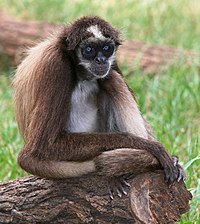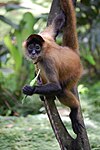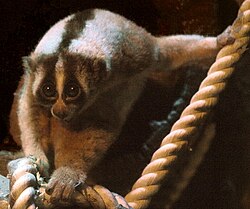The Primates Portal A primate is a member of the biological order Primates, the group that contains lemurs, the aye-aye, lorisids, galagos, tarsiers, monkeys, and apes, with the last category including great apes. With the exception of humans, who inhabit every continent on Earth, most primates live in tropical or subtropical regions of the Americas, Africa and Asia. Primates range in size from the 30-gram (1 oz) pygmy mouse lemur to the 200-kilogram (440 lb) mountain gorilla. According to fossil evidence, the primitive ancestors of primates may have existed in the late Cretaceous period around 65 mya (million years ago), and the oldest known primate is the Late Paleocene Plesiadapis, c. 55–58 mya. Molecular clock studies suggest that the primate branch may be even older, originating in the mid-Cretaceous period around 85 mya. Primates exhibit a wide range of characteristics. Some primates do not live primarily in trees, but all species possess adaptations for climbing trees. Locomotion techniques used include leaping from tree to tree, walking on two or four limbs, knuckle-walking, and swinging between branches of trees (known as brachiation). Primates are characterized by their large brains relative to other mammals. These features are most significant in monkeys and apes, and noticeably less so in lorises and lemurs. Many species are sexually dimorphic, which means males and females have different physical traits, including body mass, canine tooth size, and coloration.
Selected article
Subfossil lemurs are lemurs from Madagascar that are represented by recent (subfossil) remains dating from the late Pleistocene to approximately 560 years ago. They include both living and extinct species, although the term more frequently refers to the extinct giant lemurs. The diversity of subfossil lemur communities was higher than that of present-day lemur communities, ranging as high as 20 or more species per location, compared to 10 to 12 species today. Extinct species ranged in size from slightly over 10 kg (22 lb) to roughly 200 kg (440 lb). Even the subfossil remains of living species are larger and more robust than modern specimens. The subfossil sites found around most of the island demonstrate that most giant lemurs had wide distributions and that ranges of living species have contracted significantly since the arrival of humans.
Despite their size, the giant lemurs shared many features with living lemurs, including rapid development, poor day vision, relatively small brains, and lack of male dominance. They also had many distinct traits among lemurs, including a tendency to rely on terrestrial locomotion, slow climbing, and suspension instead of leaping, as well as a greater dependence on leaf-eating and seed predation. The giant lemurs likely filled ecological niches now left vacant, particularly seed dispersal for plants with large seeds. There were three distinct families of giant lemur, including the Palaeopropithecidae (sloth lemurs), Megaladapidae (koala lemurs), and Archaeolemuridae (monkey lemurs). Two other types were more closely related and similar in appearance to living lemurs: the giant aye-aye and Pachylemur, a genus of "giant ruffed lemurs". Subfossil remains were first discovered on Madagascar in the 1860s, but giant lemur species were not formally described until the 1890s. The paleontological interest sparked by the initial discoveries resulted in an overabundance of new species names, the allocation of bones to the wrong species, and inaccurate reconstructions during the early 1900s. Discoveries waned during the mid-1900s, although paleontological work resumed in the 1980s and resulted in the discovery of new species and a new genus. The remains of the subfossil lemurs are relatively recent, with all or most species dating within the last 2,000 years. Humans first arrived on Madagascar around that time and likely played a role in the demise of the lemurs and the other megafauna that once existed on the large island. Although hunting and habitat change have been explored as the primary cause of their extinction, a mosaic of complex interactions between multiple factors is now seen as the ultimate cause of their disappearance. Yet oral traditions and recent sightings by Malagasy villagers are still reported, suggesting either lingering populations or very recent extinctions. Selected picture The brown spider monkey, Ateles hybridus, is a species of spider monkey, a type of New World monkey, from South America. It is found in Colombia and Venezuela. Like all spider monkeys, it has very long, spindly limbs and a lengthy prehensile tail which can almost be called a fifth limb. The tail is made up of highly flexible, hairless tips with skin grooves which improves grip on tree branches and is adapted to its strictly arboreal lifestyle. It is currently critically endangered, with few examples of them remaining in the wild. CategoriesSelected species Endangered (IUCN 3.1)|Endangered The Javan slow loris (Nycticebus javanicus) is a strepsirrhine primate and a species of slow loris native to the western and central portions of the island of Java, in Indonesia. For many years, it was considered a subspecies of the Sunda slow loris (N. coucang), until the 2000s when it was promoted to full species status. It is most closely related to the Sunda slow loris and the Bengal slow loris (N. bengalensis). The species has two forms, based on hair length and, to a lesser extent, coloration. Its forehead has a prominent white diamond pattern, which is formed by a distinct stripe that runs over its head and forks towards the eyes and ears. The Javan slow loris weighs between 565–687 g (1.25–1.51 lb) and has a head-body length of about 293 mm (11.5 in). Like all lorises, it is arboreal and moves slowly across vines and lianas instead of jumping from tree to tree. Its diet typically consists of fruit, tree gum, lizards and eggs. It sleeps on exposed branches, sometimes in groups, and is usually seen alone or in pairs. The Javan slow loris population is in sharp decline due to poaching for the exotic pet trade. It is also used in research associated with traditional medicine. Remaining populations have low densities, and habitat loss is a major threat. For these reasons, the International Union for Conservation of Nature (IUCN) lists its status as "endangered," and it has also been included on the 2008–2010 list of "The World's 25 Most Endangered Primates." It is protected by Indonesian law and, since June 2007, is listed under CITES Appendix I. Despite these protections, as well as its presence in several protected areas, poaching is still incessant and the wildlife protection laws are rarely enforced at the local level. Did you know?
Primate lists
WikiProjectsThings to do
Associated WikimediaDiscover Wikipedia using portals |
© MMXXIII Rich X Search. We shall prevail. All rights reserved. Rich X Search

















